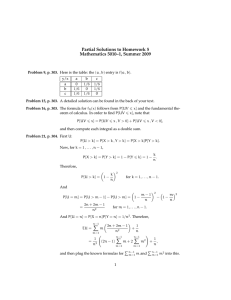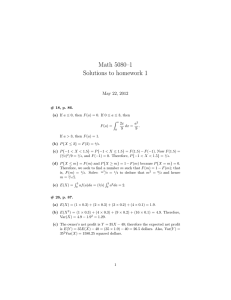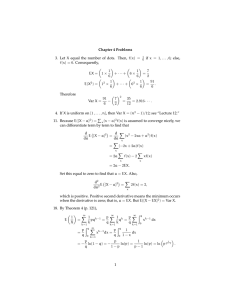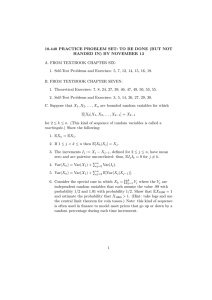Measuring Exchange Rate Fluctuations Risk Using the Value-at-Risk Abstract
advertisement
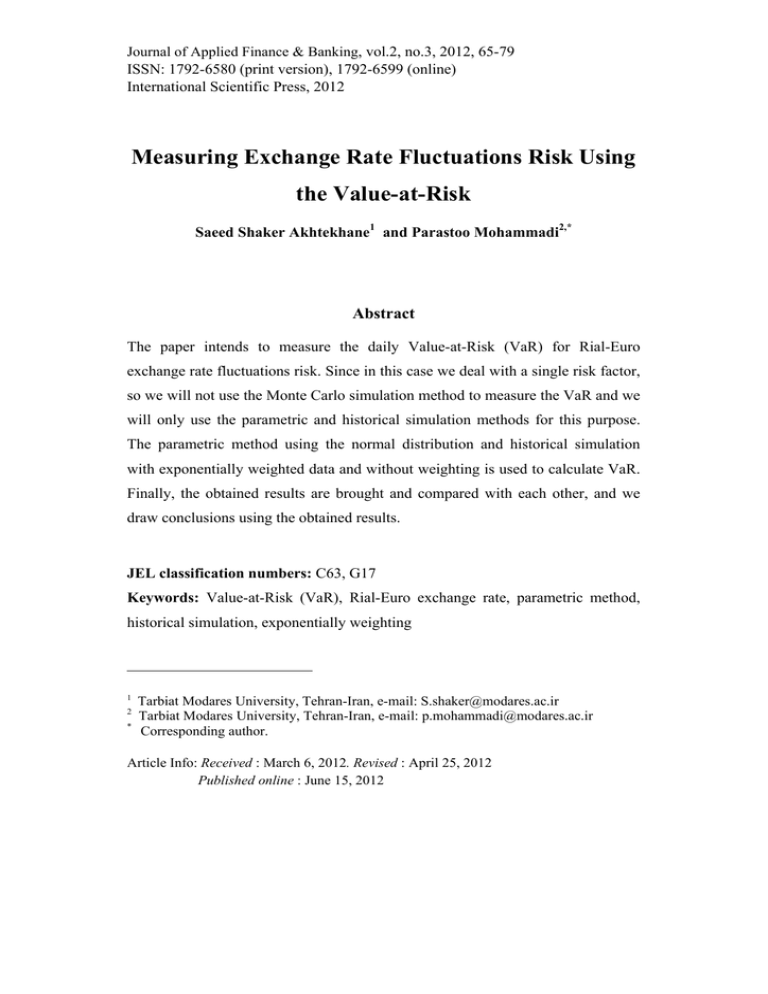
Journal of Applied Finance & Banking, vol.2, no.3, 2012, 65-79 ISSN: 1792-6580 (print version), 1792-6599 (online) International Scientific Press, 2012 Measuring Exchange Rate Fluctuations Risk Using the Value-at-Risk Saeed Shaker Akhtekhane1 and Parastoo Mohammadi2,* Abstract The paper intends to measure the daily Value-at-Risk (VaR) for Rial-Euro exchange rate fluctuations risk. Since in this case we deal with a single risk factor, so we will not use the Monte Carlo simulation method to measure the VaR and we will only use the parametric and historical simulation methods for this purpose. The parametric method using the normal distribution and historical simulation with exponentially weighted data and without weighting is used to calculate VaR. Finally, the obtained results are brought and compared with each other, and we draw conclusions using the obtained results. JEL classification numbers: C63, G17 Keywords: Value-at-Risk (VaR), Rial-Euro exchange rate, parametric method, historical simulation, exponentially weighting 1 2 * Tarbiat Modares University, Tehran-Iran, e-mail: S.shaker@modares.ac.ir Tarbiat Modares University, Tehran-Iran, e-mail: p.mohammadi@modares.ac.ir Corresponding author. Article Info: Received : March 6, 2012. Revised : April 25, 2012 Published online : June 15, 2012 66 Measuring Exchange Rate Fluctuations Risk Using the Value-at-Risk 1 Introduction Value at risk is one of the most common methods used in Risk Measurement. There are several methods to measure VaR, three basic methods are: the parametric method, historical simulation and Monte Carlo simulation. One of the most important risk factors is the risk of exchange rate fluctuations which has very large impact on the performance of banks and the economy. Because of high sensitivity in banking operations such as monetary, financial and currency exchange operations as well as sensitivity to international fluctuations and also due to the significant impact of exchange rate fluctuations on the country's economy, therefore banks as the main pillar of the country's economy influenced with exchange rate fluctuations and therefore highly insists on calculating relevant risks for measuring capital required to cover to prevent large losses or even bankruptcy. Banks use various methods and tools to calculate the relevant risks, in which each method has its own advantages and disadvantages. As proposed in 1995 and 1996 by the Basle Committee on Banking Supervision, banks are now allowed to calculate capital requirements for their trading books and other involved risks based on a VaR concept (Basle, 1995) and (Basle, 1996) and in Basel committee VaR is recognized as the most comprehensive benchmark for risk measurement. There are different classifications on the financial risks, but a holistic viewpoint divided the financial risks into five categories (Jorion. P, 2006), these categories are: 1) Market Risk: Market risk arises from movements in the level or volatility of market prices. Exchange rate, Interest rate and Stock and Commodity price risks are types of market risks. 2) Credit Risk: Credit risk originates from the fact that counterparties may be unwilling or unable to fulfill their contractual obligations. 3) Liquidity Risk: Liquidity risk takes two forms, asset liquidity risk and funding liquidity risk. S. Shaker Akhtekhane and P. Mohammadi 67 a. Asset liquidity risk arises when a transaction cannot be conducted at prevailing market prices due to the size of the position relative to normal trading lots. b. Funding liquidity risk refers to the inability to meet payments obligations, which may force early liquidation, thus transforming "paper" losses into realized losses. 4) Operational Risk: Operational risk can be defined as risk that is arising from human and technical errors or accidents. This includes fraud, management failure, and inadequate procedures and controls. 5) Legal Risk: Legal risk arises when a transaction proves unenforceable in law. Legal risk is generally related to Credit risk. In the present paper because of the importance of market risks, exchange rate risks in Iranian Banks operations and also Iran's economy, we intend to calculate exchange rate risk of Rial to Euro using VaR by the parametric and historical simulation methods in significant levels of 0.01 and 0.05. The rest of the article is organized as follows: Value at Risk is introduced in section 2, the presented VaR measurement methods are described in section 3, followed by implementing the described methods on exchange rate data in section 4, and finally section 5 presents conclusions about the obtained results. 2 Value-at-Risk In Markowitz period (1952) common comprehending of risk was a possible loss in comparison to an admissible loss. Types of losses are (Gallati, 2003): 1) Expected loss: statistical estimate of losses mean. 2) Unexpected loss: maximum loss at a specified tolerance. 3) Extra loss: somewhat higher than the maximum loss with very low probability. 68 Measuring Exchange Rate Fluctuations Risk Using the Value-at-Risk Value at risk is the unexpected loss, and tolerance level is the probability of loss occurrence that is more than the maximum of the predicted losses. Therefore, to obtain VaR it can be appropriate to focus on the left tail of the return distribution (loss distribution). So VaR is defined as the highest loss over a certain period of time at a given confidence level. Confidence level in VaR definition depends on risk aversion level of individuals involved with the issue. These are the basis for defining VaR. Suppose v is the value of an investment at the end of time horizon, so we define v* such that: v* prob(v v ) * dF (v) 1 c Where c represents the confidence level and F (v) is the cumulative distribution function. So the investment's value with the probability of 1 c will be less than v* . Now we can define VaR based on this equation. We just have to define a benchmark point so that the values less than the benchmark are considered as loss. This is common to define losses associated with the previous value of investments (v0 ) or the expected value of investment ( E (v)) , so VaR can be defined as: * VaRcZero , T v0 v * VaRcMean , T E (v ) v Where T is the time horizon, and Zero refers to the benchmark point (v0 ) and Mean refers to the benchmark point ( E (v)) . This definition of VaR is shown in Figure 1. In general, VaR is a simple statistical criterion to measure the potential losses at normal market conditions. S. Shaker Akhtekhane and P. Mohammadi 69 Figure 1: Definition of VaR 3 VaR Measurement Techniques Three basic methods to calculate VaR are (Alexander, 2008): 1) Parametric method 2) Historical simulation method 3) Monte Carlo simulation method Parametric and historical simulation methods are described in continuation followed by exponential weighting method and VaR measurement using the weighted historical simulation. 3.1 Parametric Method Parametric method is one of the basic and most straightforward techniques used in VaR measurement. The first and most fundamental property of the parametric approach assumes the distribution of returns and thus its probability density function is available, for example, assuming that the distribution of returns 70 Measuring Exchange Rate Fluctuations Risk Using the Value-at-Risk follows a normal distribution function, therefore VaR is calculated as follows (Dowd, 1998): Figure 2: Normal parametric VaR VaR F (VaR) P( R VaR) f ( R)dR a In this equation, F and R represents the cumulative distribution function and the returns random variable respectively. With standard normal distribution transform we get: VaR (VaR ) P Z a VaR 1 (a ) In these equations, Z represents the standard normal distribution variable, and are mean and standard deviation of normal distribution and is the standard normal distribution function. 3.2 Historical Simulation Method After 1998 historical simulation was introduced as a method for estimating VaR in a series of papers by Boudouhk et al., (1998) and Barone-Adesi et al., (1998). A recent survey suggests that about three-quarters of banks prefer to use S. Shaker Akhtekhane and P. Mohammadi 71 historical simulation rather than the parametric linear or Monte Carlo VaR methodologies (Perignon and Smith, 2006)3. The main advantage of the historical simulation is that historical VaR does not have to make an assumption about the parametric form of the distribution of the risk factor returns. Implementing historical simulation method for VaR measurement has four main steps: 1) Obtain historical data; the data must be long-term sufficiently4 2) Adjust the simulated data (with weighting or etc.) to reflect current market conditions. 3) Fit the empirical distribution of adjusted data. 4) Derive the VaR for the relevant significance level and risk horizon. In general, the historical VaR can be defined as follows (Alexander, 2008): The 100a % h-day historical VaR, in value terms, is the α-quantile of an empirical h-day discounted P&L distribution. Or, when VaR is expressed as a percentage of the portfolio’s value, the 100a % h-day historical VaR is the α-quantile of an empirical h-day discounted return distribution. The percentage VaR can be converted to VaR in value terms: we just multiply it by the current portfolio value. Sample size and data frequency are the most important and influential factors in historical simulation that are linked together. Obtaining a large sample of high frequency data is easier than obtaining the same sample of lower frequency data. For instance, to obtain 500 observations on the empirical distribution we would require a 20-year sample if we used 10-day returns, a 10-year sample if we used weekly returns, a 2-year sample if we used daily returns, and a sample covering only the last month or so if we used hourly returns. For assessing the regulatory market risk capital requirement, the Basel Committee recommends that a period of between 3 and 5 years of daily data be 3 In the research of Perignon and Smith in 2006, of the 64.9% of banks that disclosed their methodology 73% reported the use of historical simulation. 4 Ball Committee daily data between 3 to 5 years for suitable and adequate historical simulation has suggested (Basle, 1998). 72 Measuring Exchange Rate Fluctuations Risk Using the Value-at-Risk used in the historical simulation model (Basle, 1998). Since VaR estimates at the 99% and higher confidence levels are the norm, it is important to use a large number of historical returns5. For a 1% VaR estimation, at least 2000 daily observations on all the assets or risk factors in the portfolio should be used, corresponding to at least 20 data points in the 1% tail. But even 2000 observations would not allow the 0.1% VaR to be estimated with acceptable accuracy. However, there are several practical problems with using a very large sample. 1. Collect large volumes of historical data of the risk factors is very difficult. 2. A long historical period is likely to cover several different market regimes in which the market behavior would be very different from today, and this may cause errors in VaR estimation and the obtained results can be diverted. For a critical review of the historical simulation approach to VaR estimation see (Pritsker, 2006). 3.3 Exponentially Weighted Data and Historical VaR The main problem with all equally weighted VaR estimates is that extreme market events can influence the VaR estimate for a considerable period of time. In historical simulation, this happens even if the events occurred several times. With equal weighting, the ordering of observations is irrelevant. This problem can be mediated by weighting the returns so that their influence diminishes over time. For this purpose, we use the exponentially weighting approach, such that the weights decrease while we go toward the initial observations. Formally we can describe 5 For instance, if we were to base a 1% VaR on a sample size of 100, this is just the maximum loss over the sample. So it will remain constant day after day and then, when the date corresponding to the current maximum loss falls out of the sample, the VaR estimate will jump to another value. S. Shaker Akhtekhane and P. Mohammadi 73 the method as follow: First we define a smoothing constant in an open unit interval as (0,1) then (1 ) is assigned to the last observation ( T th observation) and (1 ) for the (T 1) th observation, therefore the weights for (T 2) th and the observations prior to the (T 2) th respectively are: 2 (1 ) , 3 (1 ) , 4 (1 ) , and so on. It can be shown that: n 1 (1 ) 1 i n 1, 0 1 i 0 Then we use these probability weights to find the cumulative probability associated with the returns when they are put in increasing order of magnitude. That is, we order the returns, starting at the smallest (probably large and negative) return, and record its associated probability weight. To this we add the weight associated with the next smallest return, and so on until we reach a cumulative probability of 100a % , the significance level for the VaR calculation. The 100a % historical VaR, as a percentage of the portfolio’s value, is then equal to minus the last return that was taken into the sum. The VaR estimation is influenced by the value chosen for . Determine an appropriate value for depends on sample size and also the time effect (i.e. the similarity and relationship between current and past data). In most cases takes the values of 0.99 or greater, if the similarity and relationship between current and past data is high then a higher value must be assigned to , and vice versa. In general, choosing a proper value for , can lead to more appropriate estimation of VaR. 74 4 Measuring Exchange Rate Fluctuations Risk Using the Value-at-Risk Measuring the Exchange Rate Risk Using Value-at-Risk In this section we use the daily Rial to Euro exchange rate data (expressed as percentage) from May 2006 to May 20116. Figure 3 represents the time series plot of available data. Time series plot of IRR to EUR Exchange rate Exchange rate (Percent) 5.0 2.5 0.0 -2.5 -5.0 1/1/2006 1/1/2007 1/1/2008 1/1/2009 date 1/1/2010 1/1/2011 Figure 3: Time series of available data Now we sought to measure the daily VaR of exchange rate fluctuations of available data at significance levels of a 0.05 and a 0.01 . Histogram of the exchange rate distribution is shown in Figure 4. 6 The data can be downloaded from (http://www.oanda.com/currency/historical-rates). S. Shaker Akhtekhane and P. Mohammadi 75 Histogram of Exchange rate data 600 500 Frequency 400 300 200 100 0 -4.5 -3.0 -1.5 0.0 IRR-->EUR 1.5 3.0 4.5 Figure 4: Histogram of the exchange rate data Histogram of Exchange rate data Normal 600 Mean StDev N 500 Frequency 400 300 200 100 0 -4.5 -3.0 -1.5 0.0 1.5 IRR-->EUR 3.0 4.5 Figure 5: Normal distribution fit to exchange rate data 0.01344 0.6840 1826 76 Measuring Exchange Rate Fluctuations Risk Using the Value-at-Risk 4.1 Results of Parametric Method In this paper we have used the normal parametric method to measure value at risk. Normal distribution fit to existing data is shown in Figure 5. Using normal parametric method, in significance levels of 0.01 and 0.05 the obtained results for VaR are -1.5778 and -1.1116 respectively. 4.2 Results of Historical Simulation Method As mentioned earlier, historical simulation with exponentially weighted data and without weighting is used to calculate VaR. a) The results for the historical simulation method with equal weights for the significance levels of 0.01 and 0.05 are -1.7171 and -1.0593 respectively. b) Since the total number of data or sample size is equal to 1090, so if we choice the value of over 0.99, we could not picture the time effect on the VaR estimation properly, and a choice of smaller value for λ might decrease and even completely destroy the effects of past data on the VaR estimation, thus we will use the value of 0.99 for . The results for the historical simulation method with exponentially weighting for the significance levels of 0.01 and 0.05 are -2.0180 and -1.1890 respectively. 4.3 Summary Results Summary results of implementing the presented methods to calculate Rial to Euro exchange rate risk are given in Table 1. S. Shaker Akhtekhane and P. Mohammadi 77 Table 1: Summary results Significance Level a 0.01 a 0.05 Normal Parametric -1.5778 -1.1116 Simple Historical -1.7171 -1.0593 -2.0180 -1.1890 VaR measure Simulation Historical Simulation with Exponentially Weighting 5 Conclusion As mentioned, in this paper we intended to measure the daily VaR for Rial-Euro exchange rate risk measurement with normal parametric and historical simulation methods. As considerable from Table 1, the results obtained with the three methods are different from each other, particularly at significance level of a 0.01 the differences between results are further. Now we'll discuss obtained results: a) Results of parametric method: If we take a look at the chart of normal distribution curve fitted to the data (Figure 5) it is obvious that the normal probability density function does not provide a proper fit to the available exchange rate data, because the kurtosis of the density obtained through the histogram is more than of the fitted normal distribution, so the error would be large. b) Results of historical simulation method: If we consider the time series plot of the data, (Figure 3) we'll find that in the last year and especially in the latter months (close to the present) the Rial-Euro exchange rate volatility is increased and this has made the recent months data quite different from prior months data. Thereupon we can conclude that the performance of historical simulation 78 Measuring Exchange Rate Fluctuations Risk Using the Value-at-Risk method with exponential weighting must be better than other methods, because this method comprises the effects of time period on the obtained VaR. Therefore we can now extract the ultimate results from the historical simulation with exponentially weighting. References [1] C. Alexander, Market risk analysis, vol. 4, Value-at-risk models, Chichester, England, Hoboken, New Jersey, John Wiley, 2008. [2] G. Barone-Adesi, F.Bourgoin and K.Giannopoulos, Market Risk: Don't Look Back, Risk -London- Risk Magazine Limited, 11, (1998), 100-103. [3] Basle Committee on Banking Supervision, An internal model-based approach to market risk capital requirements. Basle Committee on Banking Supervision, 1995, http://www.bis.org. [4] Basle Committee on Banking Supervision, Amendment to the capital accord to incorporate market risks. Basle Committee on Banking Supervision, 1996, http://www.bis.org. [5] Basle Committee on Banking Supervision, Amendment to the Basle Capital Accord of July 1988, Basle Committee on Banking Supervision, 1998, http://www.bis.org. [6] J. Bessis, Risk management in banking, Chichester, John Wiley, 1999. [7] J. Boudouhk, M. Richardson and R. Whitelaw, Value-at-risk: The Best of Both Worlds, Risk -London- Risk Magazine Limited, 11, (1998), 64-67. [8] K. Dowd, Beyond value at risk : the new science of risk management, Chichester, New York, Wiley, 1998. [9] R. Gallati, Risk management and capital adequacy, New York, London, McGraw-Hill, 2003. S. Shaker Akhtekhane and P. Mohammadi 79 [10] H.V. Grenuning and S.B. Bratanovic, Analyzing and managing banking risk : a framework for assessing corporate governance and financial risk, Washington, DC, World Bank, 2003. [11] P. Jorion, Value at Risk, 3rd edition. McGraw-Hill, New York, 2006. [12] C. Perignon and D.R.Smith, The level and quality of Value-at-Risk disclosure by commercial banks, Journal of Banking and Finance, 34, (2006), 362-377. [13] M. Pritsker, The hidden dangers of historical simulation, Journal of Banking and Finance, 30, (2006), 561. [14] B. Warwick, The handbook of risk, Hoboken, New Jersey, Wiley, 2003.

